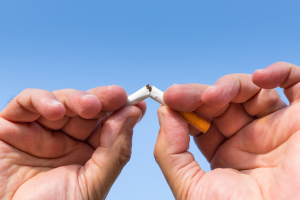Some Facts about Second-Hand Smoke
- Second-hand smoke is made up of the smoke from the burning end of a cigarette or pipe, and the smoke that is blown into the air by the person smoking.
- Second-hand smoke has over 4,700 chemicals; many of them cause cancer. Two thirds of the smoke from a cigarette is not inhaled by the smoker, but enters the air around the smoker.
- Second-hand smoke can remain in the home through contaminated dust and surfaces, even if smoking took place days, weeks and months earlier.
- Pipe smoke is as bad as cigarette smoke, and cigar smoke is worse.
- Second-hand smoke has twice as much nicotine and tar compared to the smoke that the smoker inhales.
- It has five times the amount of carbon monoxide, a deadly gas that robs the blood of oxygen
- It also contains higher levels of ammonia (better known as window cleaner) and cadmium (also found in batteries)
- The concentration of hydrogen cyanide (a poisonous gas that attacks respiratory enzymes) in tobacco smoke is considered toxic
- It contains nitrogen dioxide which is measured at fifty times higher than the standard for harm
- Many studies confirm that opening a window, smoking in another room, or using an air purifier are not effective ways to remove second-hand smoke.
- Second-hand smoke in a vehicle can be 23 times more toxic than in a house because of the smaller space. Rolling down the window does not significantly decrease your exposure to second-hand smoke.
- Babies exposed to second-hand smoke are more likely to die from Sudden Infant Death Syndrome (SIDS), also known as crib death. If you or your spouse is pregnant, Two thirds of smoke from a cigarette is not inhaled by the smoker, but enters the air around the smoker. Or you are thinking of having a baby, quitting smoking and limiting second-hand smoke exposure are important things to do.
- Second-hand smoke causes between 1,100 – 7,800 deaths per year in Canada. At least one third of the deaths are in Ontario. If you are a non-smoker, regular exposure to second-hand smoke increases your risk of developing either lung cancer or heart disease by 20%.
- Second-hand smoke aggravates symptoms in people with allergies and asthma, and can cause eye, nose and throat irritations, headaches, dizziness, nausea, coughing and wheezing in otherwise healthy people.
- Children have a higher metabolism and can absorb higher amounts of smoke than adults.
- Infants and children exposed to second-hand smoke are more likely to suffer chronic respiratory illness, impaired lung function, middle ear infections, food allergies and can even succumb to sudden infant death syndrome.
- 2.4 million Canadian homes with children under 12 years of age report regular exposure to second-hand smoke.
- Electronic air cleaning systems would need to increase the air-exchange rate a thousand fold to be effective — resulting in gale force winds!
- Increasing ventilation will dilute the smoke in a room, but will not make it safe since there is no known safe level of exposure to the carcinogens in cigarette smoke.
Canadians spend most of their time indoors.
Read More from Media
Get a personal consultation.
Feel free to contact us nearest to your location



